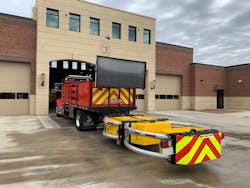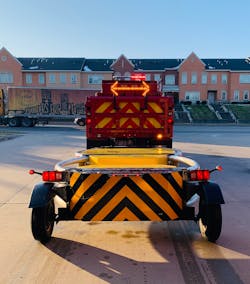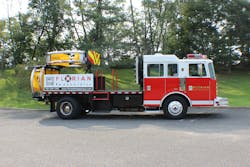Apparatus Innovations: Protecting the Protectors
More than 31,000 people died in highway accidents in the United States during the first nine months of 2021. The increase over the same period of time the previous year was the largest ever recorded. The fire service was called to assist at many of these incidents, providing firefighting, rescue and emergency medical services.
Unfortunately, operating on the side of a roadway is dangerous, and the news carries stories almost every day of apparatus that were struck and firefighters who were killed or injured by passing motorists. In March 2022, a Lafayette, LA, firefighter was injured when he jumped off of an overpass to avoid being struck by a semitrailer.
To protect the protectors, many communities introduced blocking apparatus. The vehicles are assigned routinely to provide a safer work zone for high-risk events. However, both strategy and tactics are required to achieve the desired result.
In 2019, the Emergency Responder Safety Institute published a white paper entitled, “Hardening Blocking Vehicles for Traffic Incidents and Planned Special Events.” Included was the recommendation that, “Departments should consider queue and speed-control innovations, including positioning a police unit at the back of the queue, deploying portable speed bumps or rumble strips, erecting screens, setting sequential flares, deploying folding barricades, installing a speed device to display approaching vehicles’ speeds, installing radar on emergency vehicles to detect speeding traffic and then send a ‘heads up’ alert to responders, and autonomous vehicle technology.”
The use of mesh communications networks that allow local coordination on scene also is an increasing part of accident management, as is the utilization of systems that can transmit hazard messages to motorists.
Firehouse Magazine talked to the manufacturers of traffic control devices as well as the fire departments that rely on them to learn how these crash barriers on wheels help to save lives.
Purpose-built
On Jan. 8, 2022, the Denton, TX, Fire Department put into service Blocker 3, which is an apparatus that is designed specifically for traffic control. Built on a Peterbilt chassis, the rig is designed to withstand crashes thanks to a Scorpion truck-mounted attenuator that’s on the rear. The unit folds out from storage to provide a dual-sectioned bumper between the vehicle and oncoming traffic. The vehicle has a message board, six cameras and radar. Compartments contain a large supply of traffic cones and portable speed bumps. The latter are standard equipment on all Denton apparatus.
Because Blocker 3 is built with a stake truck body, it will be available in the future for the delivery of specialized equipment to rescue scenes.
Battalion Chief David Boots says, “We had two of our engines involved in near-fatal incidents within three weeks of each other while blocking on I-35. The first one was hit at highway speed by an 18-wheeler. On the second, we had a stolen truck blow through our safety zone. The captain was exiting the engine and just had time to close the door before the hit. They had the rig parked at a 45-degree angle for blocking, and the impact straightened the engine out on the shoulder, pushing it across two lanes. One of our firefighters who was walking around the front of the apparatus when it got hit wound up riding the bumper until it came to rest.”
The total cost of Blocker 3 came to about $180,000. That’s considerably less expensive than a new pumper and a worthwhile investment when it comes to firefighter safety. Chief Kenneth Hedges underscores this point. “The safety of our members, as for any department, is paramount. On the scene of the department’s second roadway incident, I had one member state, ‘I am not afraid of being hurt in a fire. I am scared that I will get killed out on the highway by a distracted driver.’ This comment brought to reality the dangers that our members experience daily.”
On the first day that it was put in service, Blocker 3 responded to seven incidents.Vehicle repurposing
Purpose-built vehicles aren’t the only solution for protecting members while they work on roadways. Many communities are turning to rehabilitate reserve apparatus and even public works trucks. The Grand Rapids, MI, Fire Department’s repurposed dump truck, Utility 2, is an example. An attenuator trailer and a large directional arrow sign transformed the one-time water department vehicle.
“As a battalion chief, in 2011, I was tasked with taking what was being developed as Utility 2 and figuring out how to use it, as it was the first fire-based vehicle of its kind in the nation that we are aware of,” Ron Tennant, who is deputy chief of support services, says. “We have upgraded the arrow board mounted on the back from a construction-type board to an LED light stick-type indicator.”
The department also upgraded the driver’s seat, to provide for not only a more comfortable ride for the operator but better protection if that individual is sitting and secured and the vehicle struck.
The rig averages 500–600 runs per year and is supplemented with a reserve engine, as needed. When asked about the decision to opt for a towable, rather than a fixed, attenuator, Tennant says the primary reason was a towable attenuator would be easy and quick to switch out if it was damaged.
The unit has been hit several times, including one collision that knocked the wheels off of the trailer.
In contemplating trailer-mounted solutions, it’s critical to consider the trailer manufacturer’s requirements for towing the device. Minimum gross vehicle weight and hitch capacities exist. Therefore, it might be impractical to assume that any or all utility vehicles are suited for this purpose. State regulations also might apply.Retrofit
John Gonzalez, who is operations director at Florian ReApparatus, provides guidance for those who are considering a retrofit. “Retiring pumpers or rescues that are mechanically solid are generally best suited for conversion to a blocker vehicle able to accommodate rated truck-mounted attenuator units suitable for roadways with speed limits greater than 50 mph.
“When considering repurposing a vehicle from your fleet,” he continues, “it is important to separate your mindset from the vehicle’s previous function and to focus on the new intended purpose and use of this vehicle … The vehicle needs to be well-maintained and mechanically sound, as it is an emergency vehicle that will respond to emergency incidents just like any other piece of apparatus. The chassis must be solid enough to accept the mounting and carrying of the required traffic safety equipment and be able to absorb an impact.
“It is important to remember this vehicle is going to be deployed as a blocker to protect responders and frontline apparatus,” Gonzalez tells Firehouse Magazine. The overall aesthetics of the potential host vehicle should not be given a high priority when selecting the vehicle to convert, as this truck is not intended to be a parade piece.”
Although not familiar to all, certain areas of the United States operate “fire police” squads that specialize in crowd and traffic control activities. Their powers and organization vary from state to state. A blocker vehicle that’s employed by the East Hampton, NY, Fire Department lacks an attenuator, but Capt. William Mott says, “It’s a good fit and brought us into the 21st Century. It contains up-to-date communications, generators, lighting, GPS, and radios and wands that charge directly on board.”
Blocking guards
Like every other aspect of equipment and apparatus, the final decision as to the most suitable solution is a local matter. That said, whether it be an attenuator that’s mounted on a new or reserve apparatus, a repurposed municipal truck, a trailer or a vehicle that simply is designed to better show the way, traffic blocking has become as important to firefighter safety as PPE.
About the Author

Barry Furey
BARRY FUREY, who is a Firehouse Contributing Editor, provides consulting and training services in emergency communications. He is the former director of the Raleigh-Wake Emergency Communications Center in North Carolina. During his 50-year public safety career, he has managed 9-1-1 centers and served as a volunteer fire officer in three other states. In 2005, Furey received a life membership in the Association of Public-Safety Communications Officials (APCO) International for his continued work in emergency communications. Furey was inducted into the Firehouse Hall of Fame in 2017.


